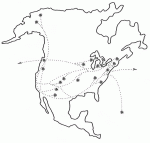Core Datasets Catalog
Work on the LTER Network Catalog of Core Data Sets is fully underway. Bill Michener and Ann Miller of North Inlet have sent production packages to site data managers, who are in the process of compiling the information.
The catalog will also be available on-line at the LTERNET host computer, initially in text format (ASCII) and later as a relational database implementation with search and query functions. Publication is scheduled for August 1990.
‘90 Directory On-Line
The 1990 LTER Personnel Directory is now available on-line at the LTERNET host computer (with the help of Bob Robbins at NSF). Included are complete addresses, phone numbers, and electronic mail addresses, as well as core research area, organism(s) and habitat(s) studied. Hard copies of the directory were also provided to all researchers listed.
The directory now has 424 entries, up 56 from 1989. The directory files, —ftp/pub/personnel, are in text format (ASCII) and can be obtained over the network by anonymous FTP (file transfer) or by dial-in. The database is also available in dBase III format as file “dir.dbf’ in the same directory. The record structure of this file, in text format, is contained in the accompanying file ‘structure.” All files are updated regularly and therefore contain the most recent version of the Personnel Directory files.
To allow tailored database queries over the network, the personnel database will be re-implemented on LTERNET using SQL-based (Structured Query Language) software. Currently, this database is implemented on a PC in dBase/Foxbase) and generates the output in WordPerfect and ASCII formats, as well as the database for the LTERNET e-mail forwarding address database.
“E-Mail” Use on the Rise
While the number of people listed in the Personnel Directory has increased by 15 percent, the number of valid electronic mail addresses has more than doubled since the 1989 edition was compiled--from 147 to 301. “E-mail” addresses are now available for 71 percent of all people listed, up 40 percent from last year.
This increase is largely due to two factors: the creation of group mailing lists at LTERNET and the work of the Connectivity Committee, which has enhanced awareness among LTER researchers of the benefits electronic communication.
LTERNET has also bridged the gap between a number of previously unconnected mail systems. Messages sent to users at the Internet host address “lternet.washington.edu” (or simply “LTERNET” on Bitnet), are now forwarded to such disparate systems as OMNET, MCImail, TELENET, NASAMAIL, DialCom (EPA), the U.S. Forest Service DG system, SPANS, and DECNET, among others. Information on how to benefit from these developments is contained in the “Guide to the LTERNET Electronic Mail Forwarding System,” now available from the Network Office.
Bulletin Board
The Andrew Message System (AMS), developed by Carnegie Mellon University and IBM with NSF’s involvement, is now running on LTERNET on an experimental basis. A limited number of users are testing AMS’s capabilities as a multimedia bulletin board and mail system.
AMS has three user interfaces at different levels. CUT (Common User Interface), is the most basic and requires only the minimal display capabilities of a teletype, often called a “dumb terminal.” VUI, (Visual User Interface), a more popular user interface, requires terminal capabilities such as VT100 or Heathl9.
MESSAGES, the most sophisticated of the AMS interfaces, requires a UNIX workstation running Xli. There is also an interface for the Apple Macintosh, MacMessages, which is similar to MESSAGES.
Connectivity Report
The LTER Connectivity Committee report, “Internet Connectivity in LTER, Assessment and Recommendations,’ was published by tne Network Office in February 1990, and has been distributed to all sites to aid researchers in improving their Internet connectivity.
With the planned acquisition of remotely sensed images through the Network Office and the availability of these images via the network, the Internet connectivity of all LTER sites is of increasing importance. This will include: securing Internet connections to all administrative headquarters and developing a minimal network infrastructure within each LTER site; enhancing local-area network capabilities to permit disk sharing, peripheral sharing and developing user friendly electronic access; providing direct electronic mail service to field laboratories; and extending full Internet connections to large field laboratories.

 Enlarge this image
Enlarge this image